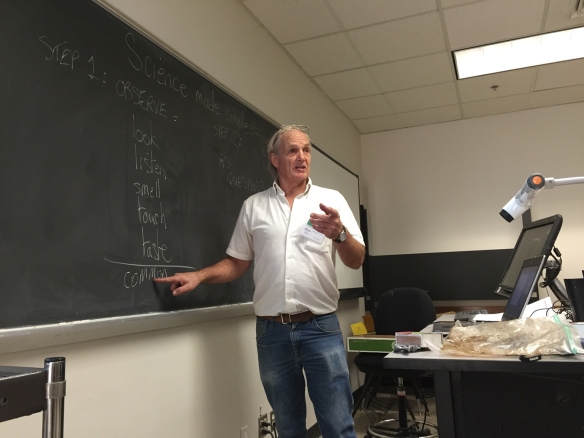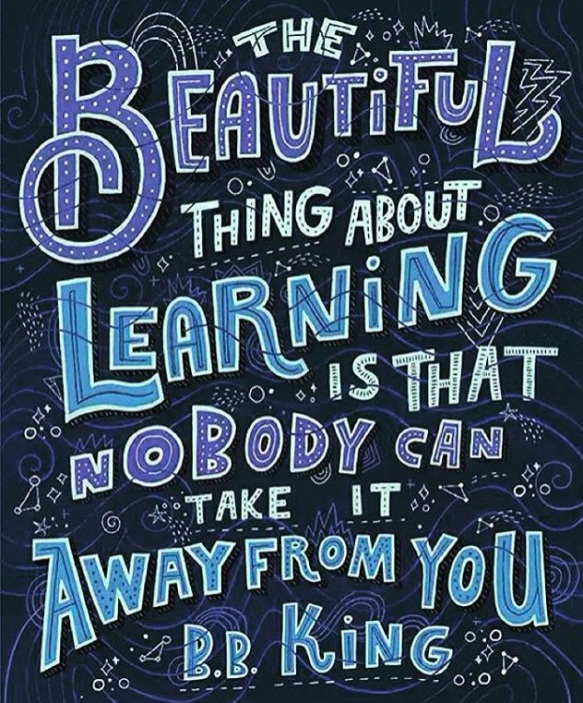Texas A&M Center for Mathematics and Science Education (CSME) researcher Dr. Craig Wilson has made a career out of science education, outreach and inquiry, inspiring countless school children across this state and nation to learn more about math and science and the many related possibilities through hands-on projects and presentations.
This past Saturday, he made his third consecutive appearance at Expanding Your Horizons, an all-day, workshop-structured conference for 6th grade girls intended to open new doors of interest and opportunity while also encouraging them to stay actively involved in math and science. Beyond making them aware of STEM (science, technology, engineering and mathematics) career opportunities, the annual event also provides the girls with a chance to meet female role models in related fields.
For his part, Craig says he learns as much as he teaches — typical, given the astute observer and encourager that he is. As the ultimate lifelong learner, he has agreed to share his educational observations via the Texas A&M Science blog in hopes of inspiring a broader audience if not horizon.
* ~ * ~ * ~ * ~ * ~ * ~ * ~ * ~ *

Texas A&M Center for Mathematics and Science Education (CMSE) research scientist Craig Wilson makes science simple for his Expanding Your Horizons audience by outlining his proven two-step method: observe and ask questions. (Credit: Chris Jarvis.)
Expanding Your Horizons . . . better known by its acronym “EYH.” You might imagine an expansive horizon, the sun sinking in the west with a myriad of colors filling the sky before darkness descends. A lone rider is riding away into that sunset in silhouette. Who is the rider? From our infatuation with Westerns, one assumes it is a cowboy. But why not a cowgirl? Perhaps it is she who has just saved The West? Why not?
EYH is designed to change that mindset from both without and within. The “Your” refers to 6th grade girls. The “Horizons” is not girls seeing a sunset but seeing science as a possible career. The “Expanding” is encouraging and helping them to look up, to look out and to look above and beyond. Just as the Orion spacecraft is looking to one day take humans to Mars, to break the shackles of low-Earth orbit where we have been trapped since 1972, so it is that EYH wants to help girls to go in science where too few girls have gone before.

In addition to being a man of many travels, Wilson boasts as rich a collection of stories as he does related props, including this preserved sample of elephant dung — a souvenir from time spent in Africa. (Credit: Chris Jarvis.)
According to the Census Bureau’s 2009 American Community Survey, women comprise 48 percent of the U.S. workforce but just 24 percent of workers in STEM (science, technology, engineering and mathematics) fields. Why is that? These girls know nothing of this, although their parents might. There are various theories, but that is unimportant on this particular Saturday. The question to be asked is, “Why have these young girls come today?” I did not ask, but I suspect that it may be because of parental interest, for each has to come with a chaperone. They have to be brought to the College of Science on the Texas A&M University campus, and 153 have made it today. This is good, because this means that their parents see this as important. They are giving their girls options. They are helping to expand their daughters’ horizons.
Today, what do the girls look like? They look interested. They look interesting. They look like potential scientists. I start my first session. They do not sit back and spectate. They participate. This is good, because this is half the battle. The other half is for them to ask questions. This is difficult, because this is not easy for girls or boys. It used to be second nature. It came naturally when they were younger. It is in the nature of scientists to inquire, to observe and to then ask questions about what they have seen. That is the way science is done, and I try to model that and have the girls see that science is much more than book learning. It is about active engagement. It can be fun. But they have to see that it is important and that they can do it as well as if not better than anyone else.

Wilson explained that peanuts are a standard astronaut snack in space because they are compact and provide lots of energy. EYH participants learned how to calculate a peanut’s calorific value by setting fire to it, heating a paper cup of water in the process. (Credit: Chris Jarvis.)
I run three sessions. At the end of each, I am encouraged. These girls have what it takes. They have the right stuff to become scientists. Sadly, not enough girls or boys see it that way. We are not getting enough students to pursue science in college. The STEM fields need them. The world needs them.
The world needs answers. She is beset by problems. We need problem solvers to step up and help her. Why not these girls? They have stepped up today. They have given up a Saturday for science. Today, they have expanded their minds. They have seen that they are not alone. Each has taken a small step for a girl but a giant leap towards a scientific horizon that they may have thought was beyond their reach.
This Texas A&M College of Science program is a small step in the right direction. It tells each girl, “You can EYH.” Yours and ours.

